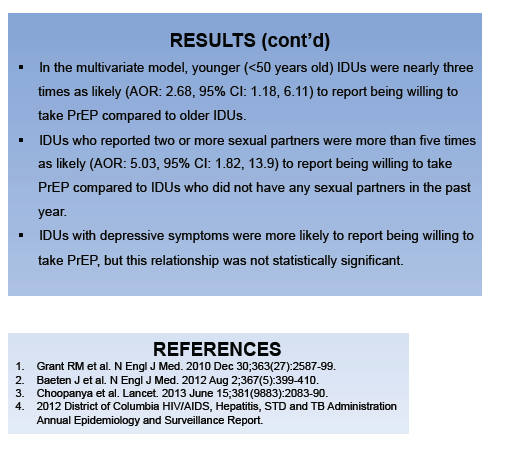 |
 |
 |
| |
Willingness to Use Pre-Exposure Prophylaxis Among
Community-Recruited Injection Drug Users
|
| |
| |
Reported by Jules Levin
CROI 2014 March 3-6 Boston, MA
Irene Kuo1, Gregory Phillips II2, Manya Magnus1, Jenevieve Opoku3, Anthony Rawls1, James Peterson1, Michael Kharfen3, Alan Greenberg1
1The George Washington University; 2Northwestern University; 3HIV/AIDS, Hepatitis, STD, TB Administration, District of Columbia Department of Health


Program Abstract
Background: Recent evidence indicates that using antiretrovirals as pre-exposure prophylaxis (PrEP) among injection drug users (IDUs) is effective in
preventing HIV transmission. We examined the correlates of the willingness to use PrEP among community-recruited active IDUs in Washington, DC.
Methodology: Data from the IDU cycle (2012) of the National HIV Behavioral Surveillance system in DC were used. IDUs were recruited using respondentdriven
sampling (RDS) and completed a detailed behavioral quantitative interview and underwent rapid testing for HIV. Data were limited to HIV-negative
IDUs who reported on willingness to use PrEP and how it might affect their drug use and sexual behaviors. RDS-weighted proportions and correlates of selfreporting
being very likely to use PrEP using unweighted multivariable analyses were reported. Potential correlates included demographic characteristics,
sexual and drug use behaviors, institutional history, depressive symptoms, and utilization of needle exchange programs. Variables attaining a univariate
p-value of ²0.05 were included in the final model.
Results: Among 304 HIV-negative IDUs, 68.0% were male, and 82.7% were 50 or older, 97.2% were black, and 69.3% had a high school diploma or
higher; the majority were unemployed or disabled. None had ever taken PrEP. 47.4% reported being very likely and 23.6% reported being somewhat likely to take PrEP if it were available and free, and 88.0% and 87.9% disagreed that they would no longer need to sterilize/clean needles or use condoms during sex if taking PrEP, respectively. Independent correlates of reporting being very likely to use PrEP included being younger (<50 years old; aOR: 2.68, 95% CI: 1.18, 6.11) and having two or more sex partners in the past 12 months compared to having none (aOR: 5.03; 95% CI: 1.82, 13.9).
Conclusions: A large proportion of active IDUs in Washington, DC reported being willing to use PrEP if it were available at no cost. IDUs who were younger
and had more sex partners reported to be more willing to use PrEP, suggesting that these groups could be targeted first to explore the practicality of PrEP
use in this population. Further research should be done to explore availability, uptake, and adherence of PrEP among IDUs.






|
| |
|
 |
 |
|
|